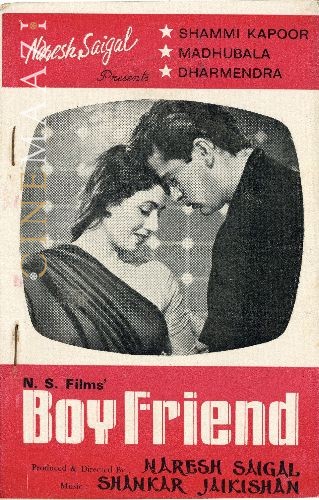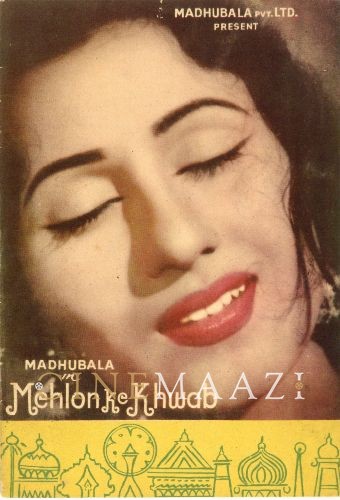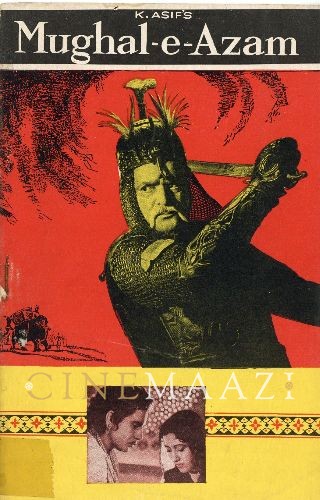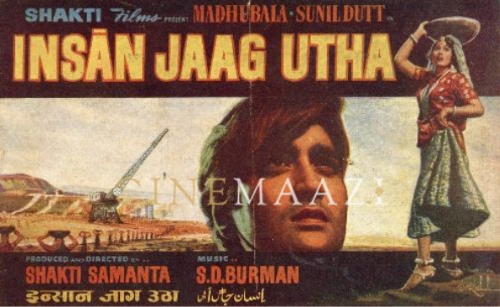Madhubala

Subscribe to read full article
This section is for paid subscribers only. Our subscription is only $37/- for one full year.
You get unlimited access to all paid section and features on the website with this subscription.
Not ready for a full subscription?
You can access this article for $2 , and have it saved to your account for one year.
- Real Name: Mumtaz Jehan Begum Dehlavi
- Born: 14 February, 1933 (Delhi)
- Died: 23 February, 1969 (Bombay)
- Primary Cinema: Hindi
- Parents: Ataullah Khan, Ayesha Begum
- Spouse: Kishore Kumar
"The Biggest Star in the World – and she's not in Beverly Hills"—thus was Madhubala described in the August 1952 issue of American magazine, Theatre Arts. The feature not only provided an insight into Madhubala's enormous popularity in India but also assessed her potential for international success. She was stunningly photographed by ace Hollywood photographer James Burke for Life magazine, again to be dubbed ‘the biggest star’ in the international industry. When Oscar award-winning director Frank Capra apparently offered to give the luminous beauty her break in Hollywood, it was declined by her protective father Ataullah Khan on the grounds that she was meant to stay in India and act in Hindi films only. And, as Dilip Kumar confirmed much later, Madhubala was a ‘very, very obedient daughter’…
It is, without doubt, entirely fitting that the sweetheart of Hindi cinema, Madhubala was born on Valentine’s Day, 14 February, in 1933. One of the most beautiful artistes to ever grace the Indian screen, she rose from humble beginnings to become perhaps the most captivating star India has ever produced. Among the most popular and highest-paid actresses of the 50s, she featured in no less than 73 films in the course of her two decade-long career. She retains a strong presence in the public memory, regularly featuring in top position in polls regarding the timeless beauties and best actresses of Indian cinema. Her birthday each year, sees various aspects of her stardom, life and career being discussed in the media. On the occasion of her 86th birth anniversary, while releasing a special doodle as tribute, Google commented: “While her breath-taking appearance earned comparisons to Venus, Madhubala was a gifted actor with an understated style well suited for comedies, dramas, and romantic roles alike. Appearing in over 70 films over the course of a tragically brief career, Madhubala—who would have turned 86 today—was called ‘The Biggest Star in the World’ in 1952 by Theatre Arts Magazine.” Interestingly, despite becoming an iconic actress of Hindi cinema, Madhubala never received any awards, but for the Filmfare Best Actress Award nomination in 1961 for her performance in Mughal-e-Azam (1960). It is the general and widespread belief that her outstanding beauty overshadowed her talent as an actress.
She was born Mumtaz Jehan Begum Dehlavi to Ayesha Begum and Ataullah Khan, the fifth of 11 children—only four of her siblings reached adulthood. Her father, Ataullah Khan, a Pashtun who lived in the Peshawar Valley (now in Pakistan), moved the family to Delhi and thereon to Bombay, after losing his job at the Imperial Tobacco Company in Peshawar. More misfortune was to follow… Their small home in Bombay was destroyed during the explosion of 1944. The silver lining: The family had survived because they were out watching a film. She was but a child when her poor Pashtun family moved to a slum in Bombay, in close proximity to the Bombay Talkies film studio in Malad. Ataullah would frequent the film studios of the city looking for work. It was thus that the 9-year-old Mumtaz was introduced to the film industry. Credited as Baby Mumtaz, she featured in her first film appearance in Basant (1942), the highest-grossing Indian film of that year. This was followed by films such as Mumtaz Mahal (1944), Kidar Sharma's Dhanna Bhagat (1945), Pujari (1946), Phoolwari (1946) and Rajputani (1946), her last film as a child artist. Incidentally, as a child artist she also sang two songs in Basant (1942): Tumko mubarak oonche mahal and Mere chote se man mein, and recorded a song for Pujari (1946).
Baby Mumtaz made the leap to playing her first lead role in the span of a year itself, when she was cast by Kidar Sharma as the leading lady in his production, Neel Kamal (1946), which had earlier been titled Bichara Bhagwaan. The film, in which she was credited as Mumtaz, was a damp squib. She was re-christened Madhubala in her next film, director Mohan Sinha’s drama, Mere Bhagwaan (1947). Madhubala did not find instant success—from Chittor Vijay (1947) and Dil Ki Rani (1947) to Mere Bhagwaan (1947), Parai Aag (1948), Amar Prem (1948) and Desh Sewa (1948), she featured in a string of lacklustre productions. The drought ended with K B Lall's Lal Dupatta (1948), which proved to be her first commercial success, also garnering praise for her competence, versatility and emotionally-delivered dialogue delivery. Her performances in films such as the thriller Sipahiya (1949), the musical Paras, as well as the thriller Aparadhi (1949) won her glowing reviews. However, it was her 1949 release, Bombay Talkies' Mahal that catapulted her to the big leagues.
Indian cinema’s first reincarnation thriller, Madhubala had been selected for the role by director Kamal Amrohi from amongst a range of leading ladies. Mahal, a big box office success, carved out the genre of Indian Gothic noir, also winning praise for its music, which remains popular to this day. Madhubala had another hit the same year—Dulari. She went on to star in a range of films across genres, such as Hanste Aansoo (1950) which was Hindi cinema’s first-ever CBFC-certified adult film, the successful Badal (1951), followed by Tarana (1951) which brought Dilip Kumar and Madhubala together onscreen for the first time.
Lacklustre films such as Sangdil (1952), Rail Ka Dibba (1953), Armaan (1953), Bahut Din Huwe (1954), and Amar (1954) which brought her critical praise for her performance, were followed by Guru Dutt’s satire Mr. & Mrs. '55 (1955). An exciting plot, hit songs, and Madhubala essaying captivating flamboyance, the film was a mega commercial success and revived her career. Her other key roles include that of a cabaret singer in Howrah Bridge (1958), involved in Calcutta's Chinatown underworld. Her enticing Asha Bhosle-rendered song Aaiye meherebaan from the film remains a heady favourite. While she starred in Kal Hamara Hai (1959) which was woven around sisters with contrasting personalities, she was paired opposite her future husband Kishore Kumar in the irresistible hit comedy Chalti Ka Naam Gaadi (1958), which was replete with hit songs such as Babu samjho ishaare, Ek ladki bheegi bhagi si, and Haal kaisa hai janab ka. Other hits saw her paired opposite Bharat Bhushan in Phagun (1958) and Dev Anand in Kala Pani (1958), and Bharat Bhushan again in the romantic musical Barsaat Ki Raat (1960). The piece de resistance, unarguably, was Mughal-e-Azam (1960). Essaying the ill-fated courtesan Anarkali in the epic historical drama, it is considered Madhubala’s greatest characterisation and finest performance ever. Depicting the star-crossed romance between Prince Salim essayed by Dilip Kumar, and Anarkali, the iconic film included landmark scenes and songs such as Pyar kiya to darna kya. Released on 5 August, 1960, the film broke box office records to become the highest-grossing Indian film of all time, an honour it held for 15 years.
She also produced films like Naata (1955) and Mehlon Ke Khwab (1960), both of which she acted in as well. While Madhubala did have releases such as Jhumroo (1961), Half Ticket (1962) and Sharabi (1964), her heart ailment, discovered in the late 50s, had worsened considerably. Her perilous heart condition saw her having to decline several powerful leading roles. She had been diagnosed with a ventricular septal defect (a hole in her heart), a congenital heart condition for which there was no treatment available then, while shooting for Bahut Din Huwe in Madras in 1954. With surgery not an option, this led to several complications, leaving the actress wracked by suffering, bed-ridden, a pale shadow of herself. With a slight improvement in health in 1966, she attempted to return to work to complete her film Chalaak opposite Raj Kapoor. However, she was unable to sustain the strain. Her last completed film was the posthumously released Jwala (1971). With acting out of the question, Madhubala explored film direction. She was to make her directorial debut with Farz Aur Ishq in 1969. However, it was not to be…
Madhubala’s career saw her directed by noteworthy filmmakers such as Mehboob Khan, Guru Dutt, Kamal Amrohi, and K. Asif in films opposite leading heroes such as Ashok Kumar, Raj Kapoor, Rehman, Pradeep Kumar, Shammi Kapoor, Dilip Kumar, Sunil Dutt and Dev Anand. However, her choice of films was largely less than satisfactory. There is a strong belief that she remains highly underrated as an actress, with her beauty attracting more attention than her talent. As her co-star Dilip Kumar later analysed, “had she lived, and had she selected her films with more care, she would have been far superior to her contemporaries...” He also explained that “actresses those days faced a lot of difficulties and constraints in their career. Unable to assert themselves too much, they fell back on their families who became their caretakers and defined everything for them.” The person in this case was her father, Ataullah Khan, who apparently guarded her fiercely, allowed her no friends, controlling both professional and personal decisions, and whose word Madhubala obediently followed.
On the personal front, Madhubala and her Mahal director Kamal Amrohi were said to be in love. However, Amrohi already being married and unwilling to divorce his wife, spelt the end to their relationship. The Madhubala-Dilip Kumar love story was highly talked about; however, her father was against the romance as it came in the early stages of her career. Dilip Kumar later revealed that her father eventually gave them permission to marry; however, it was felt by Kumar that Ataullah Khan, who owned his own production company, wanted to make ‘a business venture out of their proposed marriage’. After the Naya Naya Daur court case of 1956 in which Dilip Kumar testified against Madhubala and her father in favour of director B.R. Chopra, the relationship was beyond repair. Eventually, Madhubala married Kishore Kumar in 1960. It was reportedly not a happy marriage. With her condition worsened and being informed that she had a few more years to live, she was set up by Kumar in a separate establishment with a nurse and care-givers. Madhubala passed away in 1969 at the age of 36, due to prolonged lung and heart illness.
Assessing her star appeal, authors Harish Booch and Karing Doyle wrote in their 1962 book Self-Portrait that unlike other stars, Madhubala preferred a veiled secrecy around her and was seldom seen in social gatherings or public functions. “Contrary to general belief, Madhubala is rather simple and unassuming,” they concurred. Dilip Kumar had shared, “She was extremely popular... and I think the only star for whom people thronged outside the gates. Very often when shooting was over, there'd be a vast crowd standing at the gates just to have a look at Madhu... It wasn't so for anyone else. That was her personal effect on fans. Her personality was vivacious.”
A trendsetter, who created several iconic fashion styles, she remains significant many decades after her demise. In more recent years, a digitally-colorized version of the original Mughal-e-Azam was released, 35 years after her death. Even after all these years, it was a success. 18 March, 2008 saw a commemorative postage stamp featuring Madhubala being issued by India Post in a limited-edition presentation pack. In 2017, a statue of Madhubala was unveiled at Madame Tussauds, New Delhi, as a tribute to the actress. While the New York Times published a belated obituary for her in 2018, the following year Google commemorated her 86th birth anniversary with a special doodle. The Venus of the Indian screen remains adored and unforgettable.
-
Filmography (74)
SortRole
-

Jwala 1971
-

Sharabi 1964
-

Half Ticket 1962
-

Jhumroo 1961
-

Passport 1961
-

Boy Friend 1961
-

Jaali Note 1960
-

Mehlon Ke Khwab 1960
-

Barsat Ki Raat 1960
-

Mughal-E-Azam 1960
-

Kal Hamara Hai 1959
-

Insan Jaag Utha 1959
-







.jpg)



